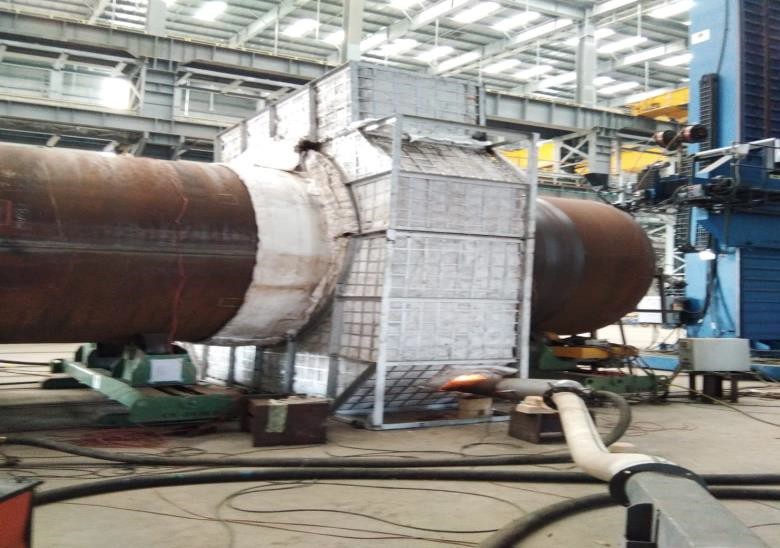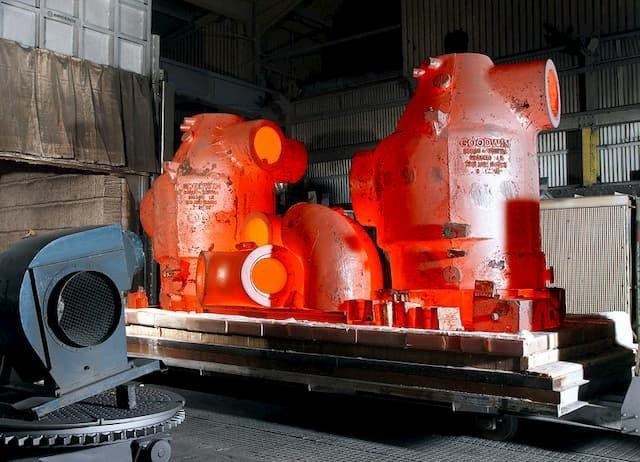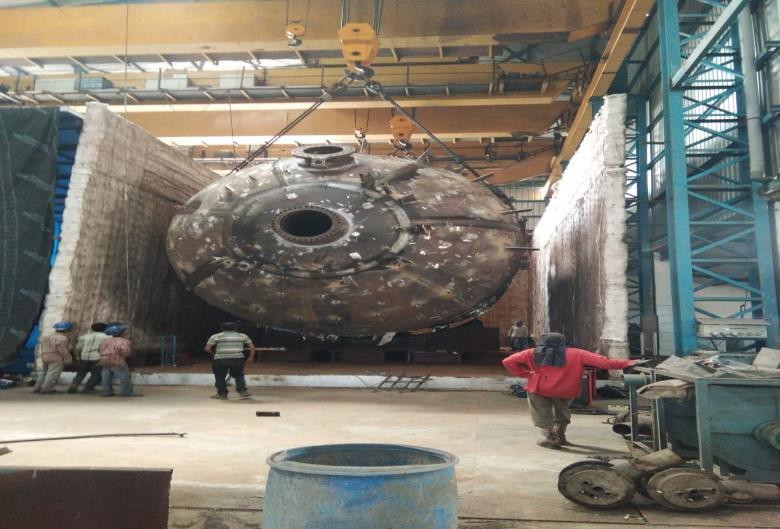Heat Treatment and NDT Services
We can carryout all types of PRE HEAT, POST WELD HEAT TREATMENT AND ALL NDT jobs by any of the process viz Electrical Resistance heating method, Internal Heating using Gas oil fired High Velocity Burner or Temporary Gas Oil Electrical Resistance Heating furnace
OIL AND INTERNAL GAS HEAT TREATMENT

Heat treatment is the process of heating and cooling metals, using specific predetermined methods to obtain desired properties. Both ferrous as well as non- ferrous metals undergo heat treatment before putting them to use.
Over time, a lot of different methods have been developed. Even today, metallurgists are constantly working to improve the outcomes and cost-efficiency of these processes.
For that they develop new schedules or cycles to produce a variety of grades. Each schedule refers to a different rate of heating, holding and cooling the metal.
These methods, when followed meticulously, can produce metals of different standards with remarkably specific physical and chemical properties.
Benefits of Heat Treatment
There are various reasons for carrying out heat treating. Some procedures make the metal soft, while others increase hardness. They may also affect the electrical and heat conductivity of these materials.
Some heat treatment methods relieve stresses induced in earlier cold working processes. Others develop desirable chemical properties to metals. Choosing the perfect method really comes down to the type of metal and the required properties.
In some cases, a metal part may go through several heat treatment procedures. For instance, some super alloys used in the aircraft manufacturing industry may undergo up to six different heat treating steps to optimize it for the application.
Heat Treatment Process Steps
In simple terms, heat treatment is the process of heating the metal, holding it at that temperature, and then cooling it back. During the process, the metal part will undergo changes in its mechanical properties. This is because the high temperature alters the microstructure of the metal. And microstructure plays an important role in the mechanical properties of a material.
The final outcome depends on many different factors. These include the time of heating, time of keeping the metal part at a certain temperature, rate of cooling, surrounding conditions, etc. The parameters depend on the heat treatment method, type of metal and part size.
Over the course of this process, the metal’s properties will change. Among those properties are electrical resistance, magnetism, hardness, toughness, ductility, brittleness and corrosion resistance.
As we already discussed, the microstructure of alloys will change during heat treatment. Heating is carried out in line with a prescribed thermal profile. An alloy may exist in one of three different states when heated. It may either be a mechanical mixture, a solid solution, or a combination of both.
A mechanical mixture is analogous to a concrete mixture where cement binds sand and gravel together. Sand and gravel are still visible as separate particles. With metal alloys, the mechanical mixture is held together by the base metal.
On the other hand, in a solid solution, all the components are mixed homogenously. This means that they cannot be identified individually even under a microscope.
Every state brings along different qualities. It is possible to change the state through heating according to the phase diagram. The cooling, though, determines the final outcome. It is possible for the alloy to end up in one of the three states, depending solely on the method.
Holding
During the holding, or soaking stage, the metal is kept at the achieved temperature. The duration of that depends on the requirements.
For example, case hardening only requires structural changes to the surface of the metal in order to increase surface hardness. At the same time, other methods need uniform properties. In this case, the holding period is longer.
The soaking time also depends on the material type and part size. Larger parts need more time when uniform properties are the objective. It just takes longer for the core of a large part to reach the required temperature.

Cooling
After the soaking stage is complete, the metal must be cooled in a prescribed manner. At this stage, too, structural changes occur. A solid solution on cooling may stay the same, become a mechanical mixture completely or partially, depending on various factors.
Different media such as brine, water, oil or forced air control the rate of cooling. The sequence of cooling media named above is in decreasing order of effective rate of cooling. Brine absorbs heat fastest, while air is the slowest.
It is also possible to use furnaces in the cooling process. The controlled environment allows for high precision when slow cooling is necessary.

Common Heat Treatment Methods
Annealing
In annealing, the metal is heated beyond the upper critical temperature and then cooled at a slow rate.
Annealing is carried out to soften the metal. It makes the metal more suitable for cold working and forming. It also enhances the metal’s machinability, ductility and toughness.
Annealing is also useful in relieving stresses in the part caused due to prior cold working processes. The plastic deformations present are removed during recrystallisation when the metal temperature crosses the upper critical temperature.
Metals may undergo a plethora of annealing techniques such as recrystallisation annealing, full annealing, partial annealing and final annealing.
Normalising
Normalising is a heat treatment process used for relieving internal stresses caused by processes such as welding, casting, or quenching.
In this process, the metal is heated to a temperature that is 40° C above its upper critical temperature.
This temperature is higher than the one used for hardening or annealing. After holding it at this temperature for a designated period of time, it is cooled in air. Normalising creates a uniform grain size and composition throughout the part.
Normalized steels are harder and stronger than annealed steel. In fact, in its normalized form, steel is tougher than in any other condition. This is why parts that require impact strength or need to support massive external loads will almost always be normalized.
Hardening
The most common heat treatment process of all, hardening is used to increase the hardness of a metal. In some cases, only the surface may be hardened.
A work piece is hardened by heating it to the specified temperature, then cooling it rapidly by submerging it into a cooling medium. Oil, brine or water may be used. The resulting part will have increased hardness and strength, but the brittleness increases too simultaneously.
Case hardening is a type of hardening process in which only the outer layer of the work piece is hardened. The process used is the same but as a thin outer layer is subjected to the process, the resultant work piece has a hard outer layer but a softer core.
This is common for shafts. A hard outer layer protects it from material wear. When mounting a bearing to a shaft, it may otherwise damage the surface and dislocate some particles that then accelerate the wearing process. A hardened surface provides protection from that and the core still has the necessary properties to handle fatigue stresses.
Stress Relieving
Stress relieving is especially common for boiler parts, air bottles, accumulators, etc. This method takes the metal to a temperature just below its lower critical border. The cooling process is slow and therefore uniform.
This is done to relieve stresses that have built in up in the parts due to earlier processes such as forming, machining, rolling or straightening.
Electrical Resistance Heating Method

Tempering
Tempering is the process of reducing excess hardness, and therefore brittleness, induced during the hardening process. Internal stresses are also relieved. Undergoing this process can make a metal suitable for many applications that need such properties.
Heat temperatures are usually much lower than hardening temperatures. The higher the temperature used, the softer the final work piece becomes. The rate of cooling does not affect the metal structure during tempering and usually, the metal cools in still air.
This heat treatment process, the metal is heated in the presence of another material that releases carbon on decomposition.
The released carbon is absorbed into the surface of the metal. The carbon content of the surface increases, making it harder than the inner core.
What Metals Are Suitable for Heat Treating?
Although ferrous metals account for the majority of heat treated materials, alloys of copper, magnesium, aluminum, nickel, brass, and titanium may also be heat treated. About 80% of heat treated metals are different grades of steel. Ferrous metals that can be heat treated include cast iron, stainless steel and various grades of tool steel.
Processes like hardening, annealing, normalizing, stress relieving, case hardening, nitriding, and tempering are generally done on ferrous metals.
Copper and copper alloys are subjected to heat treatment methods such as annealing, ageing and quenching.
Aluminum is suitable for heat treatment methods such as annealing, solution heat treating, natural and artificial ageing. Heat treatment for aluminum is a precision process. Process scope must be established and it should be controlled carefully at each stage for the desired characteristics.
POST WELD HEAT TREATMENT SERVICES
(DIRECT INTERNAL FIRING / EXTERNAL FURNACE FIRING) METHOD
AQUILA vastly experienced personnel using our High Velocity Burners can perform Post Weld Heat Treatment for a large variety of tanks, LPG bullets, pressure vessels, spheres and welded fabrication structures. One of the ways this is achieved is by constructing a temporary furnace around the items to be treated. The other way is to apply insulation directly onto the outer surface while turning the item into its own furnace, thereby ensuring the achievement of a uniform temperature so that even the highest standards and specifications are comfortably satisfied.
Our High Velocity Burner, when inserted into the vessel through a suitable manway, provides the adequate heat treatment. It is imperative that throughout the heating and cooling cycles, the expansion and contraction of the vessel must be closely monitored and controlled to avoid any distortion of the structure. Post Weld Heat Treatment will be carried out and achieve several milestones, as per the approved specified cycle of the various vessels / equipment.


What Is Nondestructive Testing?
Nondestructive testing (NDT) is the process of inspecting, testing, or evaluating materials, components or assemblies for discontinuities, or differences in characteristics without destroying the serviceability of the part or system. In other words, when the inspection or test is completed the part can still be used. In contrast to NDT, other tests are destructive in nature and are therefore done on a limited number of samples (“lot sampling”), rather than on the materials, components or assemblies actually being put into service.
These destructive tests are often used to determine the physical properties of materials such as impact resistance, ductility, yield and ultimate tensile strength, fracture toughness and fatigue strength, but discontinuities and differences in material characteristics are more effectively found by NDT.
Today modern nondestructive tests are used in manufacturing, fabrication and in-service inspections to ensure product integrity and reliability, to control manufacturing processes, lower production costs and to maintain a uniform quality level. During construction, NDT is used to ensure the quality of materials and joining processes during the fabrication and erection phases, and in-service NDT inspections are used to ensure that the products in use continue to have the integrity necessary to ensure their usefulness and the safety of the public.
It should be noted that while the medical field uses many of the same processes, the term “nondestructive testing” is generally not used to describe medical applications.
NDT Test Methods
Test method names often refer to the type of penetrating medium or the equipment used to perform that test. Current NDT methods are: Acoustic Emission Testing (AE), Electromagnetic Testing (ET), Laser Testing Methods (LM), Leak Testing (LT), Magnetic Flux Leakage (MFL), Liquid Penetrant Testing (PT), Magnetic Particle Testing (MT), Neutron Radiographic Testing (NR), Radiographic Testing (RT), Thermal/Infrared Testing (IR), Ultrasonic Testing (UT), Vibration Analysis (VA) and Visual Testing (VT).
The six most frequently used test methods are MT, PT, RT, UT, ET and VT. Each of these test methods will be described here, followed by the other, less often used test methods.
- Magnetic Particle Testing (MT)
- Liquid Penetrant Testing (PT)
- Radiographic Testing (RT)
- Ultrasonic Testing (UT)
- Electromagnetic Testing (ET)
- Visual Testing (VT)
- Acoustic Emission Testing (AE)
- Guided Wave (GW)
- Laser Testing (LM)
- Leak Testing (LT)
- Magnetic Flux Leakage (MFL)
- Neutron Radiographic Testing (NR)
- Thermal/Infrared Testing (IR)
- Vibration Analysis (VA)
